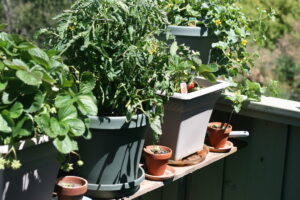Key Takeaways
-
Biochar is a carbon-rich material made from biomass, used to improve soil health and sequester carbon.
-
Charcoal, often used for cooking and heating, is made from wood and has a higher carbon footprint.
-
Biochar production is a sustainable practice that can reduce greenhouse gases and enhance soil fertility.
-
Using biochar in agriculture can increase crop yield and reduce the need for chemical fertilizers.
-
Choosing biochar over charcoal for soil amendment is a proactive step towards a more sustainable lifestyle.
Decoding the Differences: Biochar and Charcoal
Defining Biochar and Charcoal
Imagine you’re walking through a lush garden. The plants are thriving, and the air feels clean. This could be the result of using biochar, a sustainable material that breathes life into the soil. Biochar is made from organic waste like plant residues, wood chips, and agricultural byproducts. It’s designed to be mixed into the soil, where it works its magic to improve fertility and lock away carbon for centuries.
Now picture a cozy night by the fire, the smell of burning wood wafting through the air. That’s charcoal at work. Charcoal is primarily made from wood and is crafted for high-heat applications like cooking and metalworking. While it shares some similarities with biochar, it’s not typically used to enhance soil or capture carbon.
Comparing Production Techniques
The journey of biochar begins with biomass. This raw material is heated in a low-oxygen environment, a process known as pyrolysis. It’s a bit like baking a cake in a slow oven to retain all the good stuff inside. The result is a porous and rich substance that’s perfect for helping plants grow.
Charcoal’s creation is a bit different. The goal is to burn wood until it’s pure carbon, which burns hot and steady. This process, called carbonization, is not as eco-friendly as biochar’s production. It can release pollutants into the air if not done correctly.
Texture and Composition Showdown
Biochar is like a sponge, full of tiny holes that hold water and nutrients, making them available to plant roots. It’s also incredibly stable, which means it doesn’t break down quickly in the soil. This stability is key to its ability to store carbon and mitigate climate change.
Charcoal, on the other hand, has a more uniform texture and is designed to burn. It’s not as beneficial to the soil because it lacks the porous structure that biochar boasts. It’s excellent for heat but not for helping plants grow.
How Biochar Contributes to Soil Health and Carbon Sequestration
When we talk about biochar’s role in promoting soil health, we’re highlighting its superpower: the ability to hold onto nutrients and water, making them readily available for plants. This isn’t just good for the plants; it’s fantastic for the entire ecosystem. By enhancing soil fertility, biochar reduces our reliance on chemical fertilizers, which can be harmful to the environment.
But there’s more. Biochar is a heavyweight champion in carbon sequestration. This means it captures carbon dioxide from the atmosphere and stores it in a stable form within the soil. Because of its complex structure, biochar breaks down very slowly, locking away carbon for hundreds, if not thousands of years. This process not only combats climate change but also regenerates the soil, leading to a win-win situation for the planet and its inhabitants.
The Carbon Debate: Evaluating Charcoal’s Environmental Impact
-
High carbon emissions during production due to incomplete combustion.
-
Deforestation concerns linked to sourcing wood for charcoal.
-
Potential air quality issues from volatile organic compounds released when burned.
Charcoal’s environmental footprint is a topic of hot debate. While it’s a renewable resource, its production and use come with significant carbon emissions. Traditional charcoal production methods often involve inefficient burning, releasing not only carbon dioxide but also methane and other pollutants into the atmosphere.
Besides that, the demand for charcoal can drive deforestation, especially in regions where regulations are lax. This not only contributes to greenhouse gas emissions but also destroys habitats and disrupts ecosystems. When used for cooking, charcoal can also affect indoor air quality, posing health risks to those exposed to its smoke.
However, it’s not all doom and gloom. Improved charcoal production techniques, such as using kilns that capture and combust the off-gases, can reduce its environmental impact. Sustainable sourcing, like using wood from managed forests, also makes a difference. The key is to use charcoal responsibly and consider its full lifecycle impact.
Practical Applications and How to Choose
When to Opt for Biochar in Your Garden
If you’re looking to boost your garden’s productivity and sustainability, biochar is your go-to soil amendment. Here’s when you should consider using it:
-
Your soil is poor in nutrients or has difficulty retaining moisture.
-
You’re interested in organic gardening and want to reduce chemical use.
-
You’re looking to create a more resilient garden that can withstand climate fluctuations.
By incorporating biochar into your soil, you’re not just giving your plants a hearty meal, you’re also investing in the long-term health of your garden ecosystem.
Selecting the Right Charcoal for Your Needs
Charcoal is best suited for high-heat applications. If you’re choosing charcoal, whether for a barbecue or artisanal crafts, here’s what you should consider:
-
Look for sustainably sourced charcoal to minimize environmental impact.
-
Choose lump charcoal over briquettes if you’re after a purer form with fewer additives.
-
Consider the burn time and temperature required for your specific use.
By selecting the right type of charcoal for your needs, you can enjoy its benefits while still being mindful of the environment.
Here’s What You Can Do
Adopting sustainable practices doesn’t have to be overwhelming. Start small, and remember, every bit counts. Here are some actionable steps you can take:
Simple Steps to Incorporate Biochar in Your Green Lifestyle
Integrating biochar into your lifestyle is straightforward. Begin by using it in your garden or potted plants. You can also support local farmers who use biochar by buying their produce. Moreover, spread the word about biochar’s benefits to encourage others to adopt this sustainable practice.
Using Charcoal Responsibly and Efficiently
If you’re set on using charcoal, let’s do it the right way. Go for charcoal that’s been sustainably sourced, which often means it comes from well-managed forests and the process minimizes waste. When grilling, stack your charcoal tightly to get the most heat out of less fuel. After cooking, close the grill vents to put out the fire and save the remaining charcoal for next time. It’s small changes like these that add up to make a big difference.
Frequently Asked Questions
Can Biochar Replace Charcoal in Cooking?
Biochar isn’t the best charcoal solution for cooking. It’s made to enrich soil, not to generate heat for grilling your favorite dishes. Charcoal is the go-to for that smoky flavor and high heat. But don’t worry, there are sustainable charcoal options out there that can help you grill responsibly.
Is Biochar Good for All Types of Soils?
Mostly, yes. Biochar is like a universal soil booster. Whether your soil is sandy, clayey, or somewhere in between, adding biochar can improve its structure, moisture retention, and nutrient availability. But remember, every garden is unique. It’s always a good idea to start with a small amount and observe how your plants respond before going all in.
Can I Make Biochar at Home?
It’s possible, but it requires careful attention. Making biochar typically involves burning organic material in a container with very little oxygen. If you’re up for a DIY project, there are plenty of resources online to guide you through making small batches safely. Just make sure to follow the instructions closely to avoid any mishaps.
Are There Any Health Risks Associated with Charcoal Use?
When used for cooking, charcoal can emit carbon monoxide and other harmful chemicals, especially indoors or in poorly ventilated areas. Always use charcoal in open spaces and follow safety guidelines. If you have respiratory issues, you might want to avoid exposure to charcoal smoke altogether.
How Does the Switch to Biochar Impact My Carbon Footprint?
Switching to biochar can significantly reduce your carbon footprint. By using biochar in your garden, you’re locking carbon into the soil that would otherwise be in the atmosphere. This not only helps combat climate change but also revives the soil for healthier plant growth. It’s a small step for you, but a giant leap for the planet.



